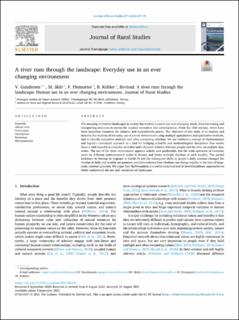A river runs through the landscape: Everyday use in an ever changing environment
Peer reviewed, Journal article
Published version

Åpne
Permanent lenke
https://hdl.handle.net/11250/3020672Utgivelsesdato
2021Metadata
Vis full innførselSamlinger
- Publikasjoner fra CRIStin - NINA [2364]
- Scientific publications [1392]
Sammendrag
The meaning of riverine landscapes to society has evolved to serve our ever-changing needs, from harvesting and transporting resources to arenas for outdoor recreation and contemplation. From the 18th century, rivers have been important resources for industry and hydroelectric power. The objective of this study is to explore and describe the rhythms of everyday use of a river environment using multiple quantitative and qualitative methods, and to identify subjective, multiple and often competing relations. We use Lefebvre’s concept of rhythmanalysis and Ingold’s contextual approach as a tool for bridging scientific and methodological disciplines. Our results show a wide breadth in everyday activities and a dynamic relation between people and the river on multiple time scales. The use of the river environment appears orderly and predictable, but the wide spectrum of everyday users on different spatiotemporal scales is diverse and forms multiple rhythms at each locality. The partial lockdown in Norway in response to Covid-19 and the subsequent shifts in people’s daily routines changed the rhythm of daily and weekly use patterns, and demonstrates how rhythms can change rapidly in the face of largescale, societal agitation. We argue that rhythmanalysis is a useful analytical tool in interdisciplinary approaches to better understand the use and valuations of landscapes.
